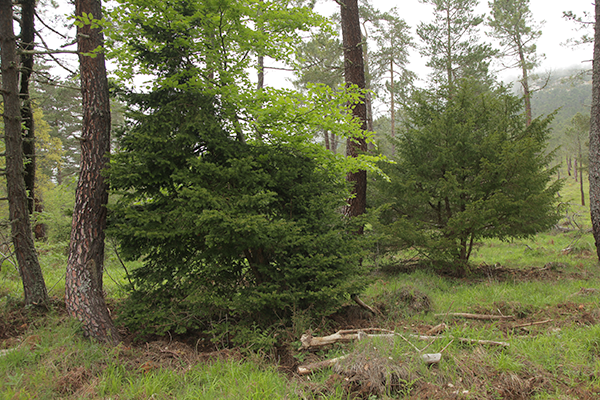LIFE BACCATA data contributes to increasing knowledge of yew in Europe
21-10-2021

The LIFE BACCATA project seeks to improve the conservation status of habitat 9580* in 15 ZEC of the Cantabrian Mountains, acting on the habitat conservation status indicators: occupation area, structure and functions, and future perspectives. The project has successfully executed its conservation and restoration strategy, also contributing to the improvement of knowledge about habitat 9580* and its main species, Taxus baccata, and generating a high interest to other actors and entities of the European Union.
As a consequence of the workfields on Northern Iberian yew populations, the article "Genetic diversity and structure of Taxus baccata from the Cantabrian-Atlantic area in northern Spain: A guide for conservation and management actions", was published in Volume 482 of Forest Ecology and Management, a prestigious journal in the forestry field. The relevance of the LIFE BACCATA data has been of such calibre that its validity has not only transcended at the level of the Cantabrian Mountains, but the information has been shared with the Center for Ecological Research and Forestry Applications (CREAF), allowing the expansion of the contextualization of the project results, contrasting them with previous works on the genetic characterization of yew at Iberian Peninsula level.
Thus, since September 21, 2021, the article "Shaping the niche of Taxus baccata, a modeling exercise using biologically meaningful information", published in Volume 501 of Forest Ecology and Management, is available online, in which invaluable information is provided for a better implementation of conservation and management policies for the species. The article incorporates the data collected by LIFE BACCATA C6 action from the more than 1,000 yew samples from 49 localities distributed in 30 SACs of Northern Iberian Natura 2000.
The publication of this article redounds in the value of the work carried out from LIFE BACCATA project, and the opportunity that LIFE program represents as the most appropriate tool to develop initiatives for the conservation of natural habitats in Natura 2000, which if the program does not exist would probably not be put into operation. These types of projects are vital, since they allow the generation of knowledge that can be incorporated into management and conservation decision-making, and which can be networked between the different European agents involved for their transfer and long-term replicability.

As a consequence of the workfields on Northern Iberian yew populations, the article "Genetic diversity and structure of Taxus baccata from the Cantabrian-Atlantic area in northern Spain: A guide for conservation and management actions", was published in Volume 482 of Forest Ecology and Management, a prestigious journal in the forestry field. The relevance of the LIFE BACCATA data has been of such calibre that its validity has not only transcended at the level of the Cantabrian Mountains, but the information has been shared with the Center for Ecological Research and Forestry Applications (CREAF), allowing the expansion of the contextualization of the project results, contrasting them with previous works on the genetic characterization of yew at Iberian Peninsula level.
Thus, since September 21, 2021, the article "Shaping the niche of Taxus baccata, a modeling exercise using biologically meaningful information", published in Volume 501 of Forest Ecology and Management, is available online, in which invaluable information is provided for a better implementation of conservation and management policies for the species. The article incorporates the data collected by LIFE BACCATA C6 action from the more than 1,000 yew samples from 49 localities distributed in 30 SACs of Northern Iberian Natura 2000.
The publication of this article redounds in the value of the work carried out from LIFE BACCATA project, and the opportunity that LIFE program represents as the most appropriate tool to develop initiatives for the conservation of natural habitats in Natura 2000, which if the program does not exist would probably not be put into operation. These types of projects are vital, since they allow the generation of knowledge that can be incorporated into management and conservation decision-making, and which can be networked between the different European agents involved for their transfer and long-term replicability.



